旅游景点 口译资料
旅游口译词汇大全

旅游口译词汇大全引言在旅游口译中,熟悉一些基本的旅游口译词汇是非常重要的。
本文将为大家提供一份旅游口译词汇大全,帮助大家更好地进行旅游口译工作。
以下是一些常用的旅游口译词汇,供大家参考。
基本词汇1. Tourist (游客)• A person who is traveling or visiting a place for pleasure or interest.•Example sentence: There were many tourists visiting the famous landmarks.2. Tour (旅游)• A journey for pleasure in which several different places are visited.•Example sentence: We went on a tour to explore the ancient city.3. Sightseeing (观光)•The activity of visiting interesting places, especially by people on holiday.•Example sentence: The tourists went sightseeing in the beautiful countryside.4. Guide (导游)• A person who shows tourists around places of interest.•Example sentence: The guide explned the history and culture of the city to the tourists.5. Destination (目的地)•The place to which someone or something is going or being sent.•Example sentence: Paris is a popular destination for tourists from all over the world.6. Itinerary (行程)• A plan or list of intended stops and activities during a journey.•Example sentence: The tour operator provided us with a detled itinerary.7. Passport (护照)•An official document issued by a government, certifying the holder’s identity and citizenship and entitling them to travel under its protection to and from foreign countries.•Example s entence: Don’t forget to bring your passport when traveling abroad.交通词汇1. rport (机场)• A complex of runways and buildings for the takeoff, landing, and mntenance of civil rcraft, with facilities for passengers.•Example sentence: We arrived at the rport two hours before the flight.2. Flight (航班)• A journey made by flying in an rcraft.•Example sentence: Our flight was delayed due to bad weather.3. Ticket (机票)• A piece of paper or card that gives the holder a certn right, especially to enter a place, travel by public transportation, or participate in an event.•Example sentence: I booked the tickets for the trn journey in advance.4. Trn (火车)• A connected set of vehicles for rl transport, running on steel rls.•Example sentence: We decided to travel by trn to enjoy the scenic views.5. Bus (公共汽车)• A large motor vehicle carrying passengers by road, typically one serving the public on a regular route and stopping to pick up or set down passengers.•Example sentence: We took a bus to the city center.6. Taxi (出租车)• A car with a driver who you pay to take you somewhere.•Example sentence: We hled a taxi to go to the hotel.7. Metro/Subway (地铁)•An underground electric rlway.•Example sentence: The city has a well-developed metro system.饮食词汇1. Restaurant (餐厅)• A place where people pay to sit and eat meals that are cooked and served on the premises.•Example sentence: We had dinner at a local restaurant.2. Menu (菜单)• A list of dishes avlable in a restaurant.•Example sentence: The wter handed us the menu to choose our food.3. Reservation (预订)•An arrangement whereby something, especially a seat or room, is booked or reserved for a particular person.•Example sentence: I made a reservation at the restaurant for tonight.4. Dish (菜品)• A particular variety or preparation of food served as part of a meal.•Example sentence: The restaurant serves a variety of delicious dishes.5. Beverage (饮料)• A drink, especially one other than water.•Example sentence: There is a wide selection of beverages avlable in the hotel.6. Tip (小费)• A sum of money given to someone as a reward for their services.•Example sentence: It is customary to leave a tip for the wter in restaurants.景点词汇1. Landmark (地标)•An object or feature of a landscape or town that is easily recognized from a distance, especially one that enables someone to establish their location.•Example sentence: The Eiffel Tower is a famous landmark in Paris.2. Monument (纪念碑)• A statue, building, or other structure erected to commemorate a notable person or event.•Example sentence: We visited the historical monuments in the city.3. Museum (博物馆)• A building in which objects of historical, scientific, artistic, or cultural interest are stored and exhibited.•Example sentence: The museum houses a collection of ancient artifacts.4. Park (公园)• A large area of public land, typically in a natural setting, for recreational activities.•Example sentence: We enjoyed a picnic in the park.5. Beach (海滩)• A pebbly or sandy shore, especially by the ocean between high- and low-water marks.•Example sentence: We spent the afternoon relaxing on the beach.6. Zoo (动物园)• A park-like area in which live animals are kept in cages or large enclosures for public exhibition.•Example sentence: The zoo has a wide variety of animals from around the world.结论以上是一些常用的旅游口译词汇,涵盖了基本词汇、交通词汇、饮食词汇和景点词汇等方面。
旅游口译材料
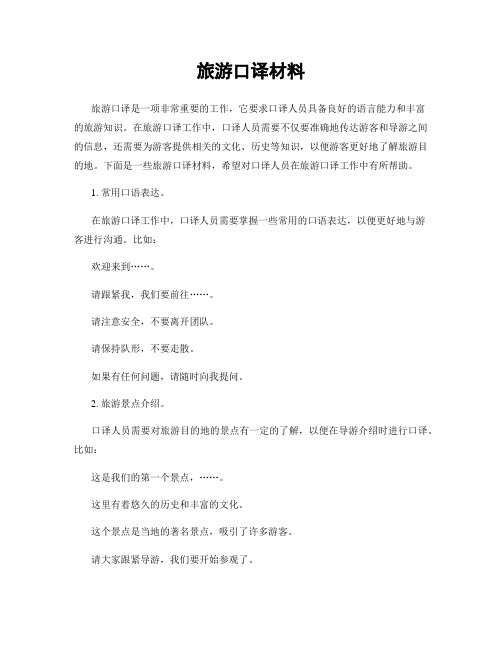
旅游口译材料旅游口译是一项非常重要的工作,它要求口译人员具备良好的语言能力和丰富的旅游知识。
在旅游口译工作中,口译人员需要不仅要准确地传达游客和导游之间的信息,还需要为游客提供相关的文化、历史等知识,以便游客更好地了解旅游目的地。
下面是一些旅游口译材料,希望对口译人员在旅游口译工作中有所帮助。
1. 常用口语表达。
在旅游口译工作中,口译人员需要掌握一些常用的口语表达,以便更好地与游客进行沟通。
比如:欢迎来到……。
请跟紧我,我们要前往……。
请注意安全,不要离开团队。
请保持队形,不要走散。
如果有任何问题,请随时向我提问。
2. 旅游景点介绍。
口译人员需要对旅游目的地的景点有一定的了解,以便在导游介绍时进行口译。
比如:这是我们的第一个景点,……。
这里有着悠久的历史和丰富的文化。
这个景点是当地的著名景点,吸引了许多游客。
请大家跟紧导游,我们要开始参观了。
3. 旅游文化知识。
在旅游口译工作中,口译人员需要向游客介绍当地的文化知识,以便游客更好地了解当地的风土人情。
比如:这是当地的传统节日,人们会……。
这里的饮食文化非常丰富,有着许多特色美食。
这里的手工艺品非常有特色,是当地的特产。
请大家尊重当地的风俗习惯,不要做出不礼貌的行为。
4. 应急口语。
在旅游过程中,可能会出现一些意外情况,口译人员需要掌握一些应急口语,以便及时处理。
比如:如果有人丢失了东西,可以向我求助。
如果有人感到身体不适,可以向我求助。
如果遇到紧急情况,请大家保持镇定,不要慌乱。
请大家遵守导游的安排,确保安全。
5. 结语。
旅游口译工作是一项需要综合能力的工作,口译人员需要不仅要具备良好的语言能力,还需要有丰富的旅游知识和一定的应急处理能力。
希望以上旅游口译材料能够对口译人员在旅游口译工作中有所帮助,让游客在旅途中更加愉快、安全。
口译中的旅游景点介绍

举世闻名的九寨沟自然保护区位于我国四川省境内,是一片纵深达35公里的自然风景区。
区内有终年积雪的山峰、苍翠繁茂的森林、宁静悠远的湖泊。
人们常常将九寨沟比作世外桃源。
Located in Sichuan Province, the World-famous Jiuzhaigou Nature Reserve covers an area of natural beauty 35 kilometers long. In the reserve there are perennially snow-topped mountain peaks, verdant and lush forests and stretches of serene lakes. Jiuzhaigou is often compared to a haven of peace, leaving behind nothing but earthly troubles and worries.九寨沟是水的天地,水构成了九寨沟最富魅力的景色。
九寨沟风景区内有许多清澈的湖泊,它们或隐匿于峡谷,或镶嵌于原始森林。
这些湖泊大小不一、形状各异,如同一面面镜子,闪耀着斑澜的光芒。
Jiuzhaigou is a world of water, which brings Jiuzhaigou its most enchanting views. Jiuzhaigou boasts many clear lakes, some of which are hidden in the valleys and some inlay the virgin forests. With a variety of shapes and sizes, these lakes look like (gleaming) mirrors projecting colorful light rings in the sunshine.四川素有“天府之国”的美称。
旅游口译词汇

一、常用词汇1.旅游目的地:tourist destinations景点:scenic spots/places of interest自然风光:natural scenery/attraction名胜古迹:places of historical interest and scenic beauty人文景观:places of historical figures and cultural heritage2.景色如画: picturesque views诱人的景色: inviting views风景优美 with picturesque/gorgeous/splendid scenery物产丰富 with rich natural resources气候宜人 pleasant/ agreeable climate美丽富饶 beautiful and fertile地形多样 a wide range of terrains多元文化 diverse cultures保存完好 well-preserved深厚的文化底蕴 profound cultural heritage浓厚的民俗风情 distinctive local traditions and customs丰富的海洋生命 abundant marine life3.江南园林亭台楼榭:pavilion, terrace, mansion, pagoda水榭:waterside pavilion湖心亭:mid-lake pavilion曲径:a winding path假山:rockeries石舫:stone boat莲花池:lotus pond九曲桥:zig-zag bridge4.自然风光雄伟的山:majestic/immense/magnificent mountains苍翠茂密的森林:verdant and lush forests宁静清澈的湖泊:serene/placid and clear lakes景色宜人,令人心旷神怡:soothing and relaxing vista饱览绚丽的风光:feast one’s eyes on the charming scenery举目远眺:look around in the distance叹为观止:marvel at无限风光:endless vistas如诗如画的江山:the poetic and picturesque land只见…:We will find ourselves carried away in involuntaryadmiration of…奇石:grotesque rock formations清瀑:clear waterfalls枫叶满山遍野;mountains overlaid with red maple leaves山外有山,景外有景:mountains beyond mountains, and scenerybeyond scenery九曲十八盘的路程:to follow the zigzag and tortuous paths珍禽奇兽:rare and precious birds and animals5.历史遗迹追溯 date back to工艺精湛: exquisite workmanship出土文物: unearthed cultural relics甲骨文: inscription on oracle bones青铜器: bronze ware景泰蓝:cloisonné enamel6.都市旅游充满活力的大都市:vibrant/dynamic/bustling city画廊 gallery7.号称…之首:Crowned as the most famous of …,誉为太湖的明珠:Like a bright pearl set on the Taihu Lake, Wu Xi …..全长…:At 6700 km in length, the River Nile……(注意句子结构)8.丰富的 a profusion of…/ a wealth of… abundant/9.旅游纪念品 souvenirs景泰蓝:cloisonné enamel泥人 clay figures手工艺品 handicrafts玉器 jadeware陶瓷 ceramics唐三彩 trio-colored ceramics文房四宝:10.著名的世界旅游景点●The Himalayas 喜马拉雅山●Great Wall, China 中国长城●Forbidden City, Beijing, China 北京故宫●Mount Fuji, Japan 日本富士山●Taj Mahal, India 印度泰姬陵●Angkor Wat, Cambodia 柬埔寨吴哥窟●Bali, Indonesia 印度尼西亚巴厘岛●Borobudur, Indonesia 印度尼西亚波罗浮屠●Sentosa, Singapore 新加坡圣淘沙●Crocodile Farm, Thailand 泰国北榄鳄鱼湖●Pattaya Beach, Thailand 泰国芭堤雅海滩●Babylon, Iraq 伊拉克巴比伦遗迹●Mosque of St, Sophia in Istanbul (Constantinople), Turkey 土耳其圣索非亚教堂●Suez Canal, Egypt 印度苏伊士运河●Aswan High Dam, Egypt 印度阿斯旺水坝●Nairobi National Park, Kenya 肯尼亚内罗毕国家公园●Cape of Good Hope, South Africa 南非好望角●Sahara Desert 撒哈拉大沙漠●Pyramids, Egypt 埃及金字塔●The Nile, Egypt 埃及尼罗河●Great Barrier Reef 大堡礁●Sydney Opera House, Australia 悉尼歌剧院●Ayers Rock 艾尔斯巨石●Mount Cook 库克山●Easter Island 复活节岛●Notre Dame de Paris, France 法国巴黎圣母院●Effiel Tower, France 法国艾菲尔铁塔●Arch of Triumph, France 法国凯旋门●Elysee Palace, France 法国爱丽舍宫●Louvre, France 法国卢浮宫●Kolner Dom, Koln, Germany 德国科隆大教堂●Leaning Tower of Pisa, Italy 意大利比萨斜塔●Colosseum in Rome, Italy 意大利古罗马圆形剧场●Venice, Italy 意大利威尼斯●Parthenon, Greece 希腊巴台农神庙●Red Square in Moscow, Russia 莫斯科红场●Big Ben in London, England 英国伦敦大笨钟●Buckingham Palace, England 白金汉宫●Hyde Park, England 英国海德公园●London Tower Bridge, England 伦敦塔桥●Westminster Abbey, England 威斯敏斯特大教堂●Monte Carlo, Monaco 摩洛哥蒙特卡罗●The Mediterranean 地中海●Niagara Falls, New York State, USA 美国尼亚加拉大瀑布●Bermuda 百慕大●Honolulu, Hawaii, USA 美国夏威夷火奴鲁鲁●Panama Canal 巴拿马大运河●Yellowstone National Park, USA 美国黄石国家公园●Statue of Liberty, New York City, USA 美国纽约自由女神像●Times Square, New York City, USA 美国纽约时代广场●The White House, Washington DC., USA 美国华盛顿白宫●Central Park, New York City, USA 美国纽约中央公园●Yosemite National Park, USA 美国尤塞米提国家公园●Grand Canyon, Arizona, USA 美国亚利桑那州大峡谷●Hollywood, California, USA 美国加利佛尼亚好莱坞●Disneyland, California, USA 加利佛尼亚迪斯尼乐园●Las Vegas, Nevada, USA 美国内华达拉斯威加斯●Miami, Florida, USA 美国佛罗里达迈阿密●Metropolitan Museum of Art, New York City, USA 纽约大都会艺术博物馆●Acapulco, Mexico 墨西哥阿卡普尔科●Cuzco, Mexico 墨西哥库斯科。
旅游景点英语对话 [关于景点的英语对话精选带翻译]
![旅游景点英语对话 [关于景点的英语对话精选带翻译]](https://img.taocdn.com/s3/m/05131910f7ec4afe05a1df31.png)
旅游景点英语对话[关于景点的英语对话精选带翻译]出国旅游,即使没有一口流利的英语,了解一些常用的旅游英语口语也是很有必要的!今天小编在这里为大家分享一些关于景点的英语对话精选,希望这些会对大家有所帮助!关于景点的英语对话一A: Anything interesting in this city?这城市有什么有趣的景点吗?B: We have a beautiful natural park.有魅力的自然公园。
A: It’s worth the ti me.值得一看。
B: Let’s go to have a visit.我们去参观一下吧。
关于景点的英语对话二Mike: Hey, Mari, so you said New York was very diverse. What parts or neighborhoods do you like?Mari: I really like Soho because there’s lots of great shopping to do. Really small shops and really cute restaurants and cafes and then if I’m lucky sometimes when I’m walking around or eating I see like movie stars, so recently before I moved back to Japan I was shopping on Broadway and I saw Claire Danes with her boyfriend. It was pretty cool.Mike: So, I always hear about Central Park. Can you tell me about Central Park?Mari: Yeah, Central Park is obviously in the middle of Manhattan. It’s really big and people go and play sports or they just hang out and walk around. If you go there on the weekends, you see a lot of joggers because the roads are closed off, so there’s no cars. Cars are not allowed, and in the summertime you see a lot of roller-bladers, and bikers.Mike: How big is the park?Mari: It’s really big. It goes from I think 56th Street to 110th, so it’s pretty large.Mike: So, what other parts?Mari: I went to grad school at Colombia so I lived right near Harlem and I actually really like Harlem because you get a very neighborhood feeling. You hear... You see people walking on the street talking to each other. You walk by the barbershop and you know that everyone knowseach other. Everyone is interested in the other. They’re gossiping about people in their neighborhood.Mike: Is there any area you don’t re ally like?Mari: Because I am from New York City, I really don’t like going to Times Square.I feel like it’s very commercial and touristy, so I really don’t like Times Square, but I guess for tourists it’s very exciting. There’s all these lights and, a nd I don’t know, it’s probably very exciting, the side street vendors, the musicians and all these things. It would be exciting for tourists, but I try to avoid it. 关于景点的英语对话三Do you know how to go to the Fragrant Hills in Beijing? I heard that they are very famous in China.你知道怎么去北京的香山吗?我听说它在中国非常有名。
口译旅游材料

1.武夷山市Wuyishan city a developing tourist named after the famous mountain in Fujian province is located in the north of Fujian province bordering Jiangxi province. It covers an area of 2798 square kilometers with a population of 208000 administering 5 towns 5 townships and 6 tea farms. The area is endowed with unique tourist resources having mild climate beautiful sights and abundant local products along with a long history and a galaxy of talents and cream of local culture. It is also one of the country’s famous production regions of tea grain and timber and a cradle of Chinese revolution. The tide of reform and opening up in China has brought the city into the opening front. Established here successively are Wuyishan National Key Nature Reserve Wuyishan National Key Scenic Spot Wuyishan National Tourist Resort and Wuyishan National Airport. And Fujian provincial government has also approved the founding of Wuyishan Tourist Economic Development Zone. During the reform and opening up Wuyishan municipal government has put emphasis on building airport railway and other facilities to improve the infrastructure. Now the city has become the center of culture and communications and a hot spot for sightseeing and for investment. The strategies of developing the city through environmental protection tourist economy science and education have been implemented in an all-round sustainable way in the city with the grand goal of becoming an international tourist city in about 15 years.武夷山市旅游武夷山市,位于福建北部的赣闽交界处,是福建省唯一以名山命名的新兴旅游城市。
旅游景点口译

Be clear of the destination. Interpreting without notes taking. (visualized
memory)
3.
Simplify the four-character phrase.
广场
Square 博物馆 Museum 纪念碑 Monument 纪念堂
Tourism in Hawaii The Hawaiian islands Fahrenheit 华氏度 = 32 + 摄氏度 × 1.8 摄氏度 = (华氏度 - 32) ÷ 1.8
Paradise
Genuine Melting pot Common ground
旅游景点
Tourist
tour
山清水秀,湖光山色
佛教名山
Famous
Beautiful
mountains and
Buddhist
lakes
mountain
这都是大自然的鬼斧神工。 These are natural wonders. 我们好像置身于世外桃源。 We all feel as we had been in a different world. 它四周树木茂盛,苍翠欲滴,以奇妙幽绝的风韵,
秀丽明媚的湖光山色,使众多游人流连忘返。
It is surrounded by trees on the lakeside and has
enchanting scenery in the lake water, which makes
people lose themselves.
口译旅游景点介绍
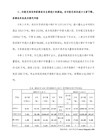
徐:是的,杭州一向被视为“人间天堂”
欧:Yes, Hangzhou has always been known as “the earthly paradise”
罗:Let’s do the west Lake first, ok?
徐:没问题. 西湖位于杭州市西部,三面环山,面积大约6.5平方公里,周边长度大约为15公里。西湖不仅因风景如画而著称,而且在这里可以找到很多学者和民族英雄的遗迹。西湖周围的很多古建筑是中国最珍贵的历史遗产,具 go there?
徐:现在就去怎么样?
罗:Wait for a moment please , I’ll take some photos first.
欧:Of course. West Lake is located in the western area of Hangzhou City. It is surrounded by mountains on three sides, with an area of around 6.5 square kilometers. The circumference is around 15 kilometers. West Lake is not only famous for its picturesque landscape, it is also associated with many scholars and national heroes. In addition, many ancient buildings in surrounding areas are among the most cherished national treasures of China, with significant artistic value.
口译专题二旅游口译资料汇总
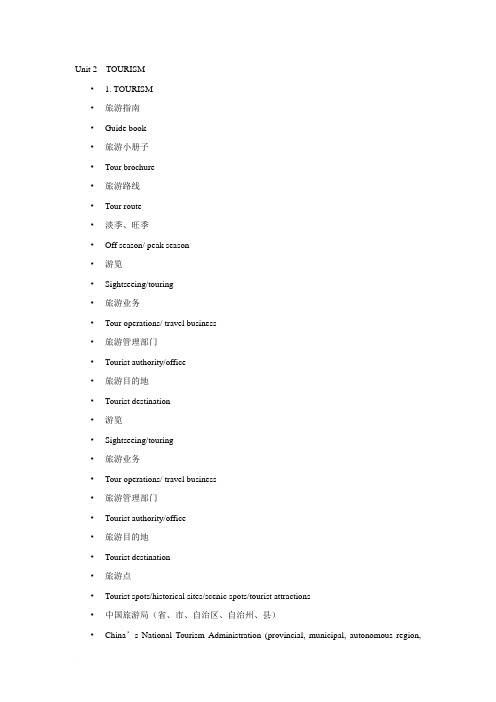
Unit 2 TOURISM• 1. TOURISM•旅游指南•Guide book•旅游小册子•Tour brochure•旅游路线•Tour route•淡季、旺季•Off season/ peak season•游览•Sightseeing/touring•旅游业务•Tour operations/ travel business•旅游管理部门•Tourist authority/office•旅游目的地•Tourist destination•游览•Sightseeing/touring•旅游业务•Tour operations/ travel business•旅游管理部门•Tourist authority/office•旅游目的地•Tourist destination•旅游点•Tourist spots/historical sites/scenic spots/tourist attractions•中国旅游局(省、市、自治区、自治州、县)•China’s National Tourism Administration (provincial, municipal, autonomous region,autonomous prefecture, county)•联合国科教文组织•UNESCO•走廊、盆地、山区、高原、平原•Corridor, basin, mountain region, plateau, plain•江南鱼米之乡•Region south of the Yangtze River flourishing in rice and fishing •六朝古都•Ancient capital of six dynasties•海滨城市•Beach city•沿海开放城市•Opening city along the coast•度假胜地•Holiday resort•国家级历史文化名城•State-list famous historical and culture cities•国家级重点风景名胜区•State-list famous region of scenic spots•世界文化遗产、自然遗产•World’s cultural heritage, natural heritageA list of tourist attraction•Forbidden City•The Ming Tombs•The Temple of Heaven•Yonghegong Lama Temple•Lugouqiao Bridge•The Confucius Temple•Baiyun Daoism Temple•The Ruins of Yuanmingyuan•The Summer Palace•Tian’anmen Square•Fragrant Hills Park•Terra Cotta Army•Huangguoshu Falls•Heaven LakeTourist Attractions in Shanghai•The Bund•Shanghai International Convention Centre•Yangpu & Nanpu Bridges•Shanghai Old Street•Shanghai Stadium•Longhua Temple•Lu Xun New Memorial Hall•Soong Ching Ling’s Mausoleum•Dr. Sun Yatsen’s Former Residence•Pedestrians Only Nanjing Road•The Oriental Pearl TV Tower•Sightseeing Tunnel at the Bund•Shanghai Wild Animal Park•Huangpu River Scenery Cruise•Temple of Jade Buddha•Shanghai City Planning Exhibition Hall•Yuyuan Garden & Bazaar•Jin Mao BuildingPassage 1万里长城据称是唯一可以从月球上望见的地球建筑物,人们可以从位于北京西北75公里以外的八达岭区直接观望到蜿蜒连绵的万里长城。
佛山旅游景点口译
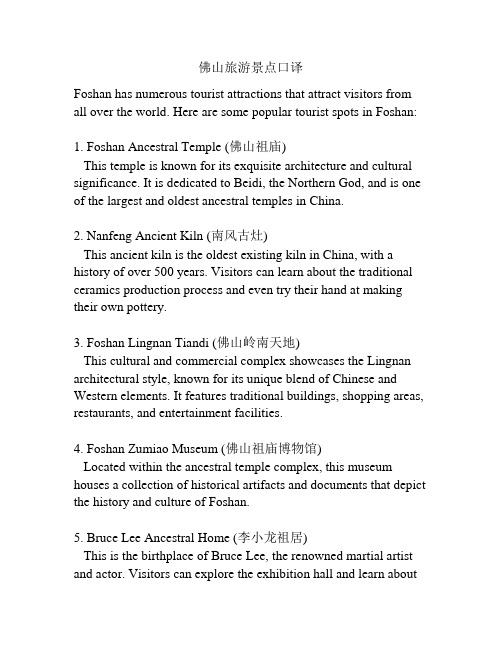
佛山旅游景点口译Foshan has numerous tourist attractions that attract visitors from all over the world. Here are some popular tourist spots in Foshan:1. Foshan Ancestral Temple (佛山祖庙)This temple is known for its exquisite architecture and cultural significance. It is dedicated to Beidi, the Northern God, and is one of the largest and oldest ancestral temples in China.2. Nanfeng Ancient Kiln (南风古灶)This ancient kiln is the oldest existing kiln in China, with a history of over 500 years. Visitors can learn about the traditional ceramics production process and even try their hand at making their own pottery.3. Foshan Lingnan Tiandi (佛山岭南天地)This cultural and commercial complex showcases the Lingnan architectural style, known for its unique blend of Chinese and Western elements. It features traditional buildings, shopping areas, restaurants, and entertainment facilities.4. Foshan Zumiao Museum (佛山祖庙博物馆)Located within the ancestral temple complex, this museum houses a collection of historical artifacts and documents that depict the history and culture of Foshan.5. Bruce Lee Ancestral Home (李小龙祖居)This is the birthplace of Bruce Lee, the renowned martial artist and actor. Visitors can explore the exhibition hall and learn aboutthe life and achievements of this iconic figure.6. Qiandeng Lake (前登湖)A picturesque lake surrounded by lush greenery, Qiandeng Lake offers a peaceful escape from the bustling city. Visitors can take a boat ride, stroll along the promenade, or simply enjoy the tranquil environment.7. Foshan Century Lotus Sports Center (佛山世纪莲体育中心) This modern sports center is a popular venue for sports events and concerts. It features a stadium, swimming pool, gymnasium, and other facilities for various sports and recreational activities.These are just some of the many attractions that Foshan has to offer. Whether you are interested in history, culture, or outdoor activities, Foshan is sure to have something for everyone.。
中高级口译常出现的旅游词汇
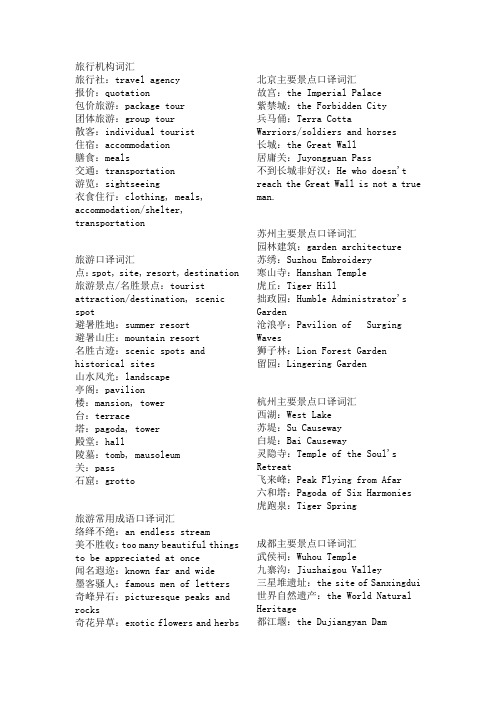
旅行机构词汇旅行社:travel agency报价:quotation包价旅游:package tour团体旅游:group tour散客:individual tourist住宿:accommodation膳食:meals交通:transportation游览:sightseeing衣食住行:clothing, meals, accommodation/shelter, transportation旅游口译词汇点:spot, site, resort, destination 旅游景点/名胜景点:tourist attraction/destination, scenic spot避暑胜地:summer resort避暑山庄:mountain resort名胜古迹:scenic spots and historical sites山水风光:landscape亭阁:pavilion楼:mansion, tower台:terrace塔:pagoda, tower殿堂:hall陵墓:tomb, mausoleum关:pass石窟:grotto旅游常用成语口译词汇络绎不绝:an endless stream美不胜收:too many beautiful things to be appreciated at once闻名遐迩:known far and wide墨客骚人:famous men of letters 奇峰异石:picturesque peaks and rocks奇花异草:exotic flowers and herbs 北京主要景点口译词汇故宫:the Imperial Palace紫禁城:the Forbidden City兵马俑:Terra CottaWarriors/soldiers and horses长城:the Great Wall居庸关:Juyongguan Pass不到长城非好汉:He who doesn't reach the Great Wall is not a true man.苏州主要景点口译词汇园林建筑:garden architecture苏绣:Suzhou Embroidery寒山寺:Hanshan Temple虎丘:Tiger Hill拙政园:Humble Administrator's Garden沧浪亭:Pavilion of Surging Waves 狮子林:Lion Forest Garden留园:Lingering Garden杭州主要景点口译词汇西湖:West Lake苏堤:Su Causeway白堤:Bai Causeway灵隐寺:Temple of the Soul's Retreat飞来峰:Peak Flying from Afar六和塔:Pagoda of Six Harmonies 虎跑泉:Tiger Spring成都主要景点口译词汇武侯祠:Wuhou Temple九寨沟:Jiuzhaigou Valley三星堆遗址:the site of Sanxingdui 世界自然遗产:the World Natural Heritage都江堰:the Dujiangyan Dam杜甫草堂:Dufu Thatched Cottage 青羊宫:Qingyang Taoist Temple。
旅游口译词汇
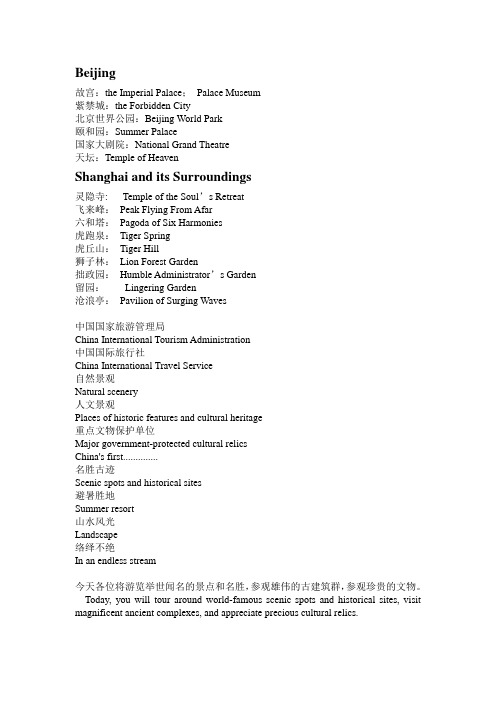
Beijing故宫:the Imperial Palace;Palace Museum紫禁城:the Forbidden City北京世界公园:Beijing World Park颐和园:Summer Palace国家大剧院:National Grand Theatre天坛:Temple of HeavenShanghai and its Surroundings灵隐寺: Temple of the Soul’s Retreat飞来峰:Peak Flying From Afar六和塔:Pagoda of Six Harmonies虎跑泉:Tiger Spring虎丘山:Tiger Hill狮子林:Lion Forest Garden拙政园:Humble Administrator’s Garden留园:Lingering Garden沧浪亭:Pavilion of Surging Waves中国国家旅游管理局China International Tourism Administration中国国际旅行社China International Travel Service自然景观Natural scenery人文景观Places of historic features and cultural heritage重点文物保护单位Major government-protected cultural relicsChina's first..............名胜古迹Scenic spots and historical sites避暑胜地Summer resort山水风光Landscape络绎不绝In an endless stream今天各位将游览举世闻名的景点和名胜,参观雄伟的古建筑群,参观珍贵的文物。
Today, you will tour around world-famous scenic spots and historical sites, visit magnificent ancient complexes, and appreciate precious cultural relics.这座寺庙历史悠久,可追溯到初唐时期。
中国十大旅游景点英语口译

一、中国著名景点介绍1. 万里长城/The Great Wall长城被誉为“世界八大奇迹”之一,是中国古代文化的象征和中华民族的骄傲。
长城的建造始于公元前7世纪的战国时期,并持续了2000多年。
它绵延6700公里,故又称作“万里长城”,是古代世界上最长的防御工事。
长城既具有优美的自然景观又具有重要的历史价值。
我们今天所见到的长城大多建于明朝时期。
经过修葺与翻新,现今最具代表性的段落如,八达岭,慕田峪,司马台,居庸关,水关,古北口等已成为世界旅游景点。
虽然今天的长城,早已失去军事价值,而以其特有的魅力,吸引着广大中外游客,成为举世闻名的旅游胜地。
Being one of the World Eight Wonders, The Great Wall is a symbol of Chinese ancient culture and the pride of the Chinese nation.Its construction began in 7th Century B.C and last over 20000 years. The Wall stretches for 12,700 li, thus known as the Ten Thousand Li Wall in China and the world longest defending works in ancient times.The Great Wall boasts both picturesque natural scenery and important historical value. The walls we see today were mostly built in Ming Dynasty. After repair and renovation, now the most representative sections such as Badaling, Mutianyu, Simatai, Juyongguan, Shuiguan, Gubeikou have become the world’s tourist attractions.Although having lost its military value, the Great Wall has become a world-renowned tourist resort ,attracting a vast majority of visitors from home and abroad with its unique interests.2.故宫/The Forbidden CityThe Forbidden City was the Chinese imperial palacefrom the Ming Dynasty to the end of the Qing Dynasty. It is located in the centre of Beijing, China, and nowhouses the Palace Museum. For almost 500 years, it served as the home of emperors and their households, as well as the ceremonial and political center of Chinese government.Built in 1406 to 1420, the complex consists of 980 buildings and covers 720,000 m2(7,800,000 sq ft).[1] The palace complex exemplifies traditional Chinese palatial architecture,[2] and has influenced cultural and architectural developments in East Asia and elsewhere. The Forbidden City was declared a World Heritage Site in 1987,[2] and is listed by UNESCO as the largest collection of preserved ancient wooden structures in the world.Since 1925, the Forbidden City has been under the charge of the Palace Museum, whose extensive collection of artwork and artifacts were built upon the imperial collections of the Ming and Qing dynasties. Part of the museum's former collection is now located in the National Palace Museum in Taipei. Both museums descend from the same institution, but were split after the Chinese Civil War.3黄山黄山位于安徽省南部.黄山已被联合国教科文组织列为自然与文化双重遗产,是中国十大风景名胜中惟一的山岳风光。
陪同口译资料(景点旅游)
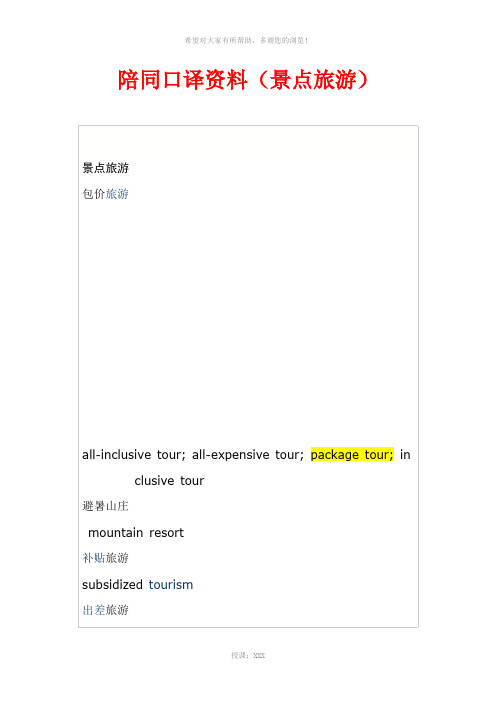
陪同口译资料(景点旅游)景点旅游包价旅游all-inclusive tour; all-expensive tour; package tour; in clusive tour避暑山庄mountain resort补贴旅游subsidized tourism出差旅游travel on official business 出土文物un earthed cultural relics春/秋游spring/autumn outing单程旅游single trip;one way travel 到处旅行travel far and wide度假胜地holiday resort佛教名山famous Buddhist mountain公事旅游travel mission工艺精湛exquisite workmanship鼓楼drum tower古建筑群ancient architectural complex 古运河旅游ancient Grand Canal tour观光旅游sight-seeing tour国画traditional Chinese painting国家公园national park国内个体旅游domestic escort tour海滨胜地beach resort area海上/航空/航天旅行sea / air / space travel海外旅游overseas travel; travel abroad 湖光山色landscape of lakes and hills环球旅游around-the-world trip (circum navigation)皇帝祭天the scenes of emperors praying for good harvests 皇家园林the imperial garden会议旅游congress tour; convention trip家庭式旅游family individual tour (FIT)假日旅行vacation tour金石印章metal and stone seals锦绣大地a land of splendors境外旅游go on a tour abroad; travel abroad 景色如画picturesque views举世闻名的旅游景观world-renowned attractions考古工作者,考古学家archaeologist历史文化名胜旅游heritage tourism疗养旅游convalescent [kɒnvə'les(ə)nt]tour旅伴traveling companion; fellow traveler旅差费traveling expenses (on a business trip)旅程;旅行日程表an itinerary[aɪ'tɪn(ə)(rə)rɪ; ɪ-]旅行社travel service/agency旅游车tourist coach ; sight-seeing / tour /tourist bus; pleasure /touring car旅游城市tourist city; city of tourism旅游管理局tourist administration bureau旅游公司tourism company旅游纪念品tourist souvenirs旅游景点a tourist destination; scenic spot; tourist attraction 旅游路线the tour route旅游签证tourist visa旅游热travel craze / boom旅游胜地tourist attraction / spot; resort旅游手册tourist guide / brochure旅游旺季peak season of tourism旅游业tourism; the tourist industry; tourist services 旅游证件travel document民俗风情folklore; folk custom民间艺术节folklore festival名山大川famous mountains and great rivers名山古刹famous mountains and magnificent temples名胜古迹scenic spots and historical sites漂流河drift river品尝风味小吃to taste the food of local taste汽车旅游motor coach tour青山绿水green hills and clear waters轻装旅行travel light人文景观places of historic figures and cultural heritage三日游a three-day tour山清水秀beautiful mountains and rivers; landscape山水风光scenery with mountains and rivers山水/水墨画landscape/ink painting时差反应jet-lag诗情画意a scene full of poetic and artistic conception 石刻碑文stone inscriptions石牌坊memorial stone archways丝绸之路the Silk Road / Route手工艺品artifact; handicrafts唐三彩tricolor-grazed ceramics of the Tang Dynasty 题咏inscriptions and poems天下第一洞the most spectacular cave unparalleled elsewhere in the world天下第一泉the finest spring under heaven土特产special local products团体旅游group / party tour文化遗产cultural heritage文人墨客men of letters; writer and poets新婚旅游honeymoon tour一日三游a three-sights-a-day tour依山临水•wedged ['wɛdʒɪd]between hills and waters•adj. 楔形的•v. 锲入有陪同的旅游conducted tour游船旅游cruise service诱人景色inviting views园林建筑garden architecture中国国际旅行社China International Travel Service中国国家旅游局China National Tourism Administration 中国民间艺术绝活Chinese unique skills in folk art珍禽奇兽和奇花异草unique and intriguing animals and flora 自然保护区nature reserve自然风光旅游nature tourism自然景观natural scenery/attraction中国有句俗话“不到长城非好汉”There is a famous Chinese saying “The one who has n’t been to the Great Wall is not a true man.”这大厅虽说已有600多年的历史,但它仍完整无缺The halls are still in excellent condition, considering t hat it was built about 600 years ago.站在顶上,你可以俯视整个地区On the top you can get a bird’s eye view of the who le area.对不起,里面不可以照相,外面可以照相留念Sorry, you can’t take pictures inside, but you may ta ke outside as a rememberance.注意你的脚下,地很滑,有好多苔藓Mind your steps. It’s slippery. A lot of mosses.当下毛毛细雨的时候,这里的景观更为壮观。
旅游口译中口

• 占地面积46.7公顷的世界公园分为17处风 景区,收集了亚洲、非洲、欧洲、南北美 洲(Americas)以及大洋洲(Oceania)的 主要名胜景点。(南极洲:Antarctic,北 极圈:Arctic) • The 46.7-hectare World Park features 17 senic areas staging all the major tourist sties of Asia, Africa, Europe, Americas and Oceania.
• • • • • • • • • • • • • • • • •
(5) World’s Tourist Attractions The Himalaya Mount Fuji Aswan High Dam Cape of Good Hope Sahara Desert The Nile Great Barrier Reef Sydney Opera House Notre Dame de Paris Eiffel Tower Arch of Triumph Leaning Tower of Pisa Big Ben in London Buckingham Palace Westminster Abbey The Mediterranean Sea Bermuda Yellowstone National Park Statue of Liberty Times Square Empire State Building Niagara Falls
• 游客可以在这里观赏(appreciate)法国的凯旋门(the Arc of Triumph)、埃菲尔铁塔(the Eiffel Tower)、罗浮宫玻璃金字塔 (the Glass Pyramid of Louvre)、凡尔赛宫(Versailles Palace )和巴黎圣母院(Notre Dame de Paris);英国伦敦的塔桥(Tower Bridge)和白金汉宫(Buckingham Palace);意大利的比萨斜塔( the Leaning Tower of Pisa)、罗马大斗兽场(the Colosseum)、 威尼斯水城和圣马可广场(Venice and St. Mark’s Square);西 班牙的阿卡沙堡(the Alcazar Castle);德国的科隆大教堂(the Cologne Cathedral);荷兰的风车和郁金香田园风光(the Idyllic sights of Windmills and Tulips);希腊的雅典卫城(the Acropolis of Athens);俄罗斯的克里姆林宫墙及钟楼(the Wall and Clock Towers of Kremlin);印度的泰姬陵(the Taj Mahal in India);泰国的泰王宫(the Grand Palace in Thailand);柬 埔寨的吴哥窟(the Angkor Wat in Combodia);缅甸的仰光大金塔 (Shwe Dagon Pagoda in Burma);新加坡的狮头鱼身像(the Merlion);澳大利亚的悉尼歌剧院(Sydney Opera House);墨西 哥的巨石头像(the Globose in Mexico);智利的复活节岛巨人石 像(the Statues of Easter Island in Chile);秘鲁的那斯卡线 画(the Linear Drawings at Nasca in Peru);中国的长城和故宫 等景物复制品(replicas of famous sights)。
旅游-风景名胜口译
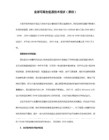
3. London, the capital of the United Kingdom, has a population of about 7 million and an area of 1580 sq km. Although it no longer ranks among the world’s most populous cities, London is still one of the world’s great centers for classical and popular culture.
游客还可以欣赏澳大利亚境内的各种珍禽奇兽,奇花异草,享受这里充足的阳光和宜人的气候。结识富有情趣、和蔼友善、胸襟宽广的澳洲人。在旅游者看来,澳大利亚是世界上最吸引人的国家之一。
2. Welcome to Queensland, Australia’s Sunshine State. With the Great Barrier Reef and surrounding islands, sun-kissed beaches and lush rainforests, Queensland offers something for everyone. And there’s no part of Queensland more colorful than the people. You’ll find the local friendly and more than accommodating.
北京同时又是一座拥有近百所高等学府,科学教育事业发达,拥有现代化通讯、交通、饭店和其他服务设施的国际化大都市;
口译旅游景点介绍
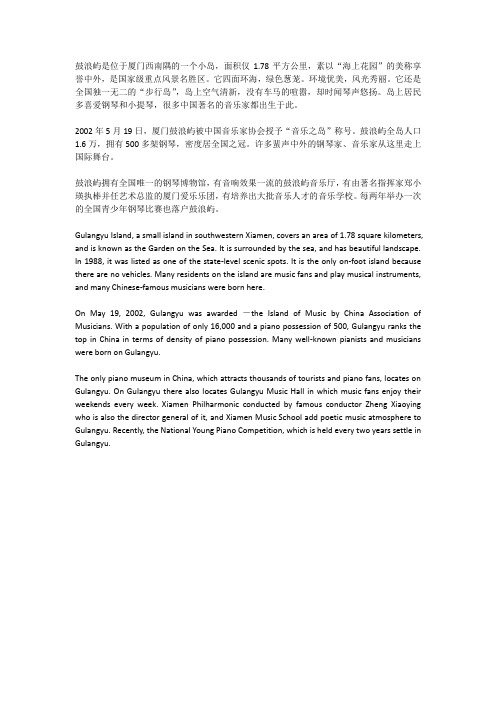
鼓浪屿是位于厦门西南隅的一个小岛,面积仅1.78平方公里,素以“海上花园”的美称享誉中外,是国家级重点风景名胜区。
它四面环海,绿色葱茏。
环境优美,风光秀丽。
它还是全国独一无二的“步行岛”,岛上空气清新,没有车马的喧嚣,却时闻琴声悠扬。
岛上居民多喜爱钢琴和小提琴,很多中国著名的音乐家都出生于此。
2002年5月19日,厦门鼓浪屿被中国音乐家协会授予“音乐之岛”称号。
鼓浪屿全岛人口1.6万,拥有500多架钢琴,密度居全国之冠。
许多蜚声中外的钢琴家、音乐家从这里走上国际舞台。
鼓浪屿拥有全国唯一的钢琴博物馆,有音响效果一流的鼓浪屿音乐厅,有由著名指挥家郑小瑛执棒并任艺术总监的厦门爱乐乐团,有培养出大批音乐人才的音乐学校。
每两年举办一次的全国青少年钢琴比赛也落户鼓浪屿。
Gulangyu Island, a small island in southwestern Xiamen, covers an area of 1.78 square kilometers, and is known as the Garden on the Sea. It is surrounded by the sea, and has beautiful landscape. In 1988, it was listed as one of the state-level scenic spots. It is the only on-foot island because there are no vehicles. Many residents on the island are music fans and play musical instruments, and many Chinese-famous musicians were born here.On May 19, 2002, Gulangyu was awarded ―the Island of Music by China Association of Musicians. With a population of only 16,000 and a piano possession of 500, Gulangyu ranks the top in China in terms of density of piano possession. Many well-known pianists and musicians were born on Gulangyu.The only piano museum in China, which attracts thousands of tourists and piano fans, locates on Gulangyu. On Gulangyu there also locates Gulangyu Music Hall in which music fans enjoy their weekends every week. Xiamen Philharmonic conducted by famous conductor Zheng Xiaoying who is also the director general of it, and Xiamen Music School add poetic music atmosphere to Gulangyu. Recently, the National Young Piano Competition, which is held every two years settle in Gulangyu.。
导游、旅游口译词汇

导游口译词汇(Vocabulary of Guide Interpreting)旅行社:travel agency旅游指南; guidebook导游实践:guide practice国际导游:international tourism旅游计划,节目:itinerary本地导游:local guide全陪:national guide淡季:off season ;low season旺季:peak season;on season领队:tour leader旅游线路:tour route游客:tourist旅游业:travel trade旅游景点/名胜景点:tourist attraction/destination; scenic spot;places of tourist attraction 自然景观:naturel splendor;tourist attraction;国家公园:national park古建筑群:ancient architectural complex避暑胜地:summer resort.避暑山庄:mountain resort.名胜古迹:scenic spot and historical sites.山水风光:landscape.石笋:stalagmite亭阁:pavilion坛:altar 廊:corridor琉璃瓦:glazed tile庵:Buddhist nunnery江河湖泊:rivers and lakes池潭:ponds and pools楼:mansion; tower台:terrace堤:causeway舫:boat榭:pavilion,house on the terrace水榭:waterside pavilion/house塔:pagoda; tower殿堂:hall陵墓:tomb;mausoleum。
关: pass石窟:grotto故宫: the imperial palace/the Forbidden City紫禁城:the forbidden city兵马俑:terra cotta warriors/soldiers and horses长城:the great wall居庸关;juyongguan pass不到长城非好汉:he who does'n reach the great wall is not a ture man.第1页共1页。
- 1、下载文档前请自行甄别文档内容的完整性,平台不提供额外的编辑、内容补充、找答案等附加服务。
- 2、"仅部分预览"的文档,不可在线预览部分如存在完整性等问题,可反馈申请退款(可完整预览的文档不适用该条件!)。
- 3、如文档侵犯您的权益,请联系客服反馈,我们会尽快为您处理(人工客服工作时间:9:00-18:30)。
Beijing1.The Forbidden CityThe Forbidden City was the Chinese imperial palace from the Ming Dynasty to the end of the Qing Dynasty, and now houses the Palace Museum. It was built in 1406 to 1420, the complex consists of 980 buildings and covers 720,000 m2 (7,800,000 sq ft). For almost 500 years, it served as the home of emperors and their households, as well as the ceremonial and political center of Chinese government. The palace complex exemplifies traditional Chinese palatial architecture, and has influenced cultural and architectural developments in East Asia and elsewhere. The Forbidden City was declared a World Heritage Site in 1987, and is listed by UNESCO as the largest collection of preserved ancient wooden structures in the world.2.The Great WallThe Great Wall of China is a series of fortifications made of stone, brick, tamped earth, wood, and other materials, generally built along an east-to-west line across the historical northern borders of China in part to protect the Chinese Empire or its prototypical states against intrusions by various nomadic groups or military incursions by various warlike peoples or forces. The entire wall with all of its branches measure out to be 21,196 km (13,171 mi) and it stretches from Shanhaiguan in the east, to Lop Lake in the west. The wall built between 220–206 BC by the first Emperor of China, Qin Shi Huang and the majority of the existing wall was reconstructed during the Ming Dynasty. Other purposes of the Great Wall have included border controls, allowing the imposition of duties on goods transported along the Silk Road, regulation or encouragement of trade and the control of immigration and emigration.3.The Summer PalaceThe Summer Palace, or officially in China Garden of Nurtured Harmony, is a vast ensemble of lakes, gardens and palatial buildings in Beijing, China. The Summer Palace is mainly dominated by Longevity Hill and the Kunming Lake. It covers an expanse of 2.9 square kilometers, three-quarters of which is water.In December 1998, UNESCO included the Summer Palace on its World Heritage List. It declared the Summer Palace "a masterpiece of Chinese landscape garden design. The natural landscape of hills and open water is combined with artificial features such as pavilions, halls, palaces, temples and bridges to form a harmonious ensemble of outstanding aesthetic value."4.The Temple of HeavenThe Temple of Heaven, literally the Altar of Heaven is a complex of religious buildings situated in the southeastern part of central Beijing. The complex was visited by the Emperors of the Ming and Qing dynasties for annual ceremonies of prayer to Heaven for good harvest. It has been regarded as a Taoist temple, although Chinese Heaven worship, especially by the reigning monarch of the day, pre-dates Taoism.5.Tian'anmen SquareTian'anmen Square is a large city square in the center of Beijing, China, named after the Tian'anmen Gate located to its North, separating it from the Forbidden City. Tian'anmen Square is the third largest city square in the world. It has great cultural significance as it was the site of several important events in Chinese history.6.Old Summer PalaceThe Old Summer Palace, known in Chinese as Y uan Ming Y uan, and originally called the Imperial Gardens, was a complex of palaces and gardens in Beijing. It is located 8 kilometers northwest ofthe walls of the Imperial City and was built in the 18th and early 19th century as the place where the emperors of the Qing Dynasty resided and handled government affairs. The Old Summer Palace was known for its extensive collection of garden and building architectures and other works of art. In 1860 during the Second Opium War, it was destroyed by French and British troops.7.Ming Dynasty TombsThe Ming Dynasty Tombs are located some 42 kilometers north-northwest of central Beijing, within the suburban Changping District of Beijing municipality. The site, located on the southern slope of Tianshou Mountain (originally Mount Huangtu), was chosen on the feng shui principles by the third Ming Dynasty emperor Yongle (1402–1424), who moved the capital of China from Nanjing to its the present location in Beijing. After the construction of the Imperial Palace (the Forbidden City) in 1420, the Yongle Emperor selected his burial site and created his own mausoleum.8.Olympic GreenThe Olympic Green is an Olympic Park in Chaoyang District, Beijing, China constructed for the 2008 Summer Olympics. Since then, the streets around the park have been used for an exhibition street race of the FIA GT1 World Championship in 2011, after a race at Goldenport Park Circuit in the vicinity.9.The Y onghe TempleThe Yonghe Temple, also known as the "Palace of Peace and Harmony Lama Temple", the "Yonghe Lamasery", or popularly the "Lama Temple", is a temple and monastery of the Geluk School of Tibetan Buddhism located in the northeastern part of Beijing, China. The building and the artworks of the temple is a combination of Han Chinese and Tibetan styles. Building work on the Yonghe Temple started in 1694 during the Qing Dynasty. It originally served as an official residence for court eunuchs. It was then converted into the court of the Prince Yong (Yin Zhen), a son of the Kangxi Emperor and himself the future Yongzheng Emperor. After Yongzheng's ascension to the throne in 1722, half of the building was converted into a lamasery, a monastery for monks of Tibetan Buddhism. The other half remained an imperial palace.10.Jingshan ParkJingshan is an artificial hill covering an area of more than 230,000 m², and is immediately north of the Forbidden City on the central axis of Beijing. Originally an imperial garden, it is now a public park, known as Jingshan Park.Jingshan's history dates to the Liao and Jin Dynasties, almost a thousand years ago. The 45.7-metre high artificial hill was constructed in the Yongle era of the Ming Dynasty entirely from the soil excavated in forming the moats of the Imperial Palace and nearby canals. The last emperor of the Ming Dynasty, Chongzhen, committed suicide by hanging himself here in 1644.Shanghai1.The Oriental Pearl TowerThe Oriental Pearl Radio & TV Tower is a TV tower in Shanghai, China. Its location at the tip of Lujiazui in the Pudong district by the side of Huangpu River, opposite the Bund, makes it a distinct landmark in the area. Construction began in 1991, and the tower was completed in 1994. At 468 m (1,535 feet) high, it was the tallest structure in China from 1994–2007.The tower is brightly lit in different LED sequences at night. On 7 July 2007, Oriental Pearl Tower was host tothe Chinese Live Earth concert.2.Yu GardenYu Garden or Yuyuan Garden is an extensive Chinese garden located beside the City God Temple in the northeast of the Old City of Shanghai, China. A centerpiece is the Exquisite Jade Rock , a porous 3.3-m, 5-ton boulder. Rumours about its origin include the story that it was meant for the imperial palace in Beijing, but was salvaged after the boat sank off Shanghai.3.LujiazuiLujiazui, formerly known as Lokatse from its pronunciation in Shanghainese, is a locality in Shanghai, a peninsula formed by a bend in the Huangpu River. Since the early 1990s, Lujiazui has been developed specifically as a new financial district of Shanghai. The decision to earmark Lujiazui for this purpose reflects its location: it is located on the east side of the Huangpu River in Pudong, and sits directly across the river from the old financial and business district of the Bund.4.The BundThe Bund is a waterfront area in central Shanghai. The area centres on a section of Zhongshan Road (East-1 Zhongshan Road) within the former Shanghai International Settlement, which runs along the western bank of the Huangpu River, facing Pudong, in the eastern part of Huangpu District. The Bund usually refers to the buildings and wharves on this section of the road, as well as some adjacent areas. It is one of the most famous tourist destinations in Shanghai. Building heights are restricted in this area.5.ZhujiajiaoZhujiajiao is an ancient town located in the Qingpu District of Shanghai. The population of Zhujiajiao is 60,000. Zhujiajiao is a water town on the outskirts of Shanghai, and was established about 1,700 years ago. Archaeological findings dating back 5,000 years have also been found. 36 stone bridges and numerous rivers line Zhujiajiao, and many ancient buildings still line the riverbanks today.6.The China pavilionThe China pavilion at Expo 2010 in Shanghai, China, colloquially known as the Oriental Crown, was the largest national pavilion at the Shanghai Expo and the largest display in the history of the World Expo. It was also the most expensive pavilion at the Shanghai Expo costing an estimated US$220 million. The pavilion showcased China’s civilization and modern achievements by combining traditional and modern elements in its architecture, landscaping and exhibits. After the end of the Expo 2010, the building was converted to a museum. On October 1, 2012, it was reopened as the China Art Museum, the largest art museum in Asia.7.Jing’an TempleJing'an Temple is a Buddhist temple on the West Nanjing Road in Shanghai, China. Jing'an District, where it is located, is named after the temple. The temple was first built in 247 AD in the Wu Kingdom during the Three Kingdoms period of ancient China. Originally located beside the Suzhou Creek, it was relocated to its current site in 1216 during the Song Dynasty. The current temple was rebuilt in the Qing Dynasty and renovated several times.8.Jin Mao TowerThe Jin Mao Tower is an 88-story landmark skyscraper in the Lujiazui area of the Pudong district of Shanghai, People's Republic of China. It contains offices and the Shanghai Grand Hyatt hotel. Until 2007 it was the tallest building in the PRC, the fifth tallest in the world by roof height and the seventh tallest by pinnacle height. Along with the Oriental Pearl Tower, it is part of the Pudongskyline. Its height was surpassed on September 14, 2007 by the Shanghai World Financial Center which is next to the building. The Shanghai Tower, a 128-story building located next to these two buildings and now under construction, will be even taller.9.Shanghai Ocean AquariumThe Shanghai Ocean Aquarium is a public aquarium located in Shanghai, China. Designed by Advanced Aquarium Technologies, the aquarium includes a 120-meter (390 ft) tunnel that takes visitors through a coastal reef, open ocean, a kelp cave, shark cove, and a coral reef, and is one of the longest such tunnels in the world. It is home to an Oranda goldfish named Bruce after Bruce Lee which measures 17.129 inches (435.1 mm) in length.10.Shanghai Science and Technology MuseumShanghai Science and Technology Museum is a large museum in Pudong, Shanghai, close to Century Park, the largest park within the inner districts of the city. The museum covers an area of 68,000 square metres, a floor space of 98,000 square metres and an exhibition space of 65,500 square metres with planned visiting flow of 2,000,000 to 3,000,000 visitors per year and investment of RMB 1.755 billion Yuan. As of July 2010 the museum will have attracted over 23,000,000 visitors making it one of China's most visited modern museums.Guangzhou1.Baiyun MountainBaiyun Shan, Baiyun Mountain, or Mount Baiyun is a mountain near Guangzhou, officially part of the Baiyunshan Resort along with Luhu Park, Yuntai Garden, Mingchungu Scenic Area, Monxinling Scenic Area, Mingzhulou Scenic Area, Yunxi Ecological Park, and Baiyun Sculpture Park. Baiyun Mountain is a park with natural hills and lakes, and an ideal sightseeing place and summer resort, with a development history of over 1,000 years.2.Chen Clan AcademyThe Chen Clan Academy is an academic temple in Guangzhou, built by the 72 Chen clans for their juniors' accommodation and preparation for the imperial examinations in 1894 in Qing Dynasty. Later i t was changed to be the Chen Clan’s Industry College, and then middle schools afterward. Now it houses the Guangdong Folk Art Museum.Located at Zhongshan 7th Road, the Chen Clan Academy is a symmetric complex consist of 19 buildings with nine halls and six courtyards. The Chen Clan Academy complex exemplifies traditional Chinese architecture and decoration style, and has influenced cultural and architectural developments worldwide. It was added in the list of "Cultural Relics of National Importance under the Protection of the State" in 1988.3.Pearl RiverThe Pearl River or Zhu Jiang or less commonly, the "Guangdong River" or "Canton River" etc., is an extensive river system in southern China. Measured from the farthest reaches of the Xi Jiang, the Pearl River system is China's third longest river, and second largest by volume. The 409,480 km² Pearl River Basin drains the majority of South Central (Guangdong and Guangxi provinces), as well as parts of Southwest (Yunnan,Guizhou, Hunan and Jiangxi provinces) in China, and Northeast of Vietnam (Cao Bằng and Lạng Sơn).Zhujiang Brewery, one of the three largest domestic breweries in China, is located on the Pearl River Delta within the city of Guangzhou. 4.The Museum of the Mausoleum of the Nanyue KingThe Museum of the Mausoleum of the Nanyue King is a museum in Jiefangbei Road, YuexiuDistrict, Guangzhou, southern China. With an area of 1,4000 sq. m, the tomb is the witness of Guangzhou’s history of over 2,000 years. It is well known for its well-preserved tomb and funerary antiquity from the Han Dynasty, as well as elegant and grand architecture from the Lingnan (south of the Nanling Mountain) area. The owner of the tomb is the second king of Nanyue, Zhao Mo (r. 137 BC – 122 BC).5.The Temple of the Six Banyan TreesThe Temple of the Six Banyan Trees is an ancient Buddhist temple originally built in 537 in the Liang Dynasty in Guangzhou, southern China. The temple's proximity to foreign consulates in Guangzhou has made it a regular destination for families participating in the international adoption of children from China. Typically families receive blessings for their newly adopted children at this temple in front of the statue of Kuan Yin.6.Guangxiao TempleGuangxiao Temple on Guangxiao Road is one of the oldest Buddhist temples in Guangzhou. It was the mansion of Prince Zhao Jiande of the Nanyue Kingdom during the Western Han Dynasty (206 B.C.-A.D.24). The temple was initially built by an Indian monk during the Eastern Jin Dynasty (317- 420) but the present temple, occupying an area of 31,000 square meters, dates from the Qing Dynasty (1644 - 1911). The temple has an important place in Buddhist history as Huineng of the Zen Buddhist sect was a novice monk here in the 7th century.7.Shangxiajiu Pedestrian StreetShangxiajiu Pedestrian Street, is a commercial pedestrian street in Liwan District, Guangzhou, Guangdong, China. It is the first business street in Guangzhou opened in September 1995. Shangxiajiu is composed of the unique and historical architecture based on Tong Lau and teahouses, featuring the characteristics of European and Chinese styles.8.Tianhe StadiumTianhe Stadium is a multi-purpose stadium in Guangzhou, China. It is currently used mostly for football matches. The stadium has a seating capacity of 58,500. It was built in 1987 and hosted the final of the inaugural FIFA Women's World Cup in 1991. The stadium has hosted large crowds and attendances of local football team Guangzhou Evergrande are played at the stadium. On February 7, 1989 Lunar New Year, Hong Kong Television Broadcasts Limited and Guangdong Television Broadcasts Limited were situated in the Guangzhou Tianhe Sports Centre and at the White Swan Hotel for the Chinese New Year Celebration in Guangzhou. The stadium hosted the football finals of the 2010 Asian Games and matches of the 2012 AFC Champions League.9.Mount XiqiaoMount Xiqiao is a 40-50 million year old dormant volcano situated in the south west of the Nanhai District, Foshan, Guangdong, People’s Republic of China some 68 km (42 mi) from Guangzhou. The mountain is an important scenic area and designated as a national forest park and national geological park. Covering an area of 14 square kilometres (5.4 sq mi), the area features a total of 72 peaks with the highest, Dacheng Peak, rising to346 m (1,135 ft).10.Canton TowerCanton Tower, formerly known as Guangzhou TV Astronomical and Sightseeing Tower and also known as Guangzhou Tower, is a 600 m-high (2,000 ft) multi-purpose Chinese observation tower in the Haizhu District of Guangzhou(historically known as Canton or Kwangchow, Guangdong, China. The tower was topped out in 2009 and it became operational on 29 September 2010 for the 2010 Asian Games. The tower briefly held the title of tallest tower in the world, replacing the CNTower, before being surpassed by the Tokyo Skytree in 2011. It is the tallest structure in China and the fourth-tallest freestanding structurein the world. Its incipient height is 600 m in 2010.Chongqing1.Three Natural BridgesThe Three Natural Bridge sare a series of natural limestone bridges located in Xiannüshan Town , Wulong County, Chongqing Municipality, People's Republic of China. They lie within the Wulong Karst National Geology Park, itself a part of the South China Karst-Wulong Karst UNESCO World Heritage Site. In Chinese, the bridges are all named afterdragons, namely the Tianglong, Qinglong and Heilong bridges.2.Furong CaveFurong Cave is a karst cave located on the banks of the Furong River, 20 km (12 mi) from Wulong County town, Chongqing, People's Republic of China. First discovered by local farmers in 1993 the cave was opened to tourists in 1994. It became a national 4A tourist site in 2002 then in June 2006 part of the South China Karst UNESCO World Heritage Site ; the only cave in China on the UNESCO list.3.Dazu Rock CarvingsThe Dazu Rock Carvings are a series of Chinese religious sculptures and carvings, dating back as far as the 7th century AD, depicting and influenced by Buddhist, Confucian and Taoist beliefs. Listed as a World Heritage Site, the Dazu Rock Carvings are made up of 75 protected sites containing some 50,000 statues, with over 100,000 Chinese characters forming inscriptions and epigraphs. The sites are located in Chongqing Municipality within the steep hillsides throughout Dazu County, located about 60 kilometers west of the urban area of Chongqing. The highlights of the rock grotto are found on Mount Baoding and Mount Beishan.4.Jiiefangbei CBDJeifangbei CBD, also known as Jiefangbei Shangye Buxingjie, is an ultra-dense urbanized downtown in Chongqing, China, centred around a large pedestrian mall and landmark monument tower. The area surrounding the monument tower makes up the main central business district of the Yuzhong District of Chongqing city and is the most prominent CBD in the in teriour of China. Thousands of shops, bars, and restaurants are located in Jeifangbei CBD including large international department stores, designer boutiques, local street food stalls, movie theatres, bars, and dance clubs; all clustered in pedestrian only streets surrounding the Jeifangbei monument and pedestrian square. The pedestrian square itself is lined with numerous giant mega-shopping malls with jumbo-tron LED screens and illuminated advertising billboards along with the city's tallest commercial skyscrapers, best known international hotels and luxury residential accommodation.5.CiqikouCiqikou is an ancient town in the Shapingba District of Chongqing Municipality, People's Republic of China, originally called Longyinzhen was also known as Little Chongqing. According to an old Chinese proverb: "One flagstone road, and one thousand years' Ciqikou". The name of the town can be traced back to porcelain production during the Ming (1368–1644) and Qing Dynasties. Formerly a busy port located at the lower reaches of the Jialing River, a thousand years after its foundation the town remains a symbol and microcosm of old Chongqing (Jiang Zhou). 6.Chaotianmen BridgeThe Chaotianmen Bridge, is a road-rail bridge over the Yangtze River in the city of Chongqing,China. The bridge which opened on 29 April 2009 is the world's longest arch bridge. The continuous steel truss arch bridge with tie girders has a main span of 552 metres (1,811 ft) and a total length of 1,741 m (5,712 ft). It carries 6 lanes in two ways and a pedestrian lane on each side on the upper deck, and dual light rails in the middle and 2 traffic lanes on each side on the lower deck.7.BaidichengBaidi or Baidicheng( 8 km east of the present day Fengjie County seat in Chongqing municipality), is an ancient temple complex on a hill on the northern shore of the Yangtze River in China. The name literally means City of the White Emperor. It is said that the area was once surrounded with a white mist, giving it a rather mysterious yet serene look, much like what an emperor should be like. It has also been said that someone saw a white dragon, the symbol of the Emperor come out there, and the warlord Gongsun Shu thought this was a fortuitous sign, and declared himself Emperor of Chengja. He founded the city and called himself the White Emperor.In 2006, the Chinese government established Baidi city as a national heritage site.8.Furong RiverThe Furong River, also known as the Pangu River is the largest tributary of the Wu River and flows through Guizhou Province and Chongqing Municipality, People's Republic of China. Rising in the Dalou Mountains in Suiyang County, Guizhou Province, the river flows from the south west northeast to Chongqing where it joins the Wu River at Jiangkou Town in Wulong County.The Furong River National Park extends for 35 kilometres (22 mi) from Jiangkou Town and encompasses 152.2 square kilometres (58.8 sq mi) of the original canyon. In 2002, the Chinese State Council listed the area as a National Park then in 2007 a section of the river became part of the South China Karst UNESCO World Heritage Site.9.Wu RiverThe Wu River is the largest southern tributary of the Yangtze River and one part of it is in Chongqing. Nearly its entire length of 1,150 kilometres runs within the isolated, mountainous and ethnically diverse province of Guizhou. The river takes drainage from a 80,300-square-kilometre watershed.The river flows through the Liupanshui, Anshun, Guiyang (the capital), Qiannan, and Zunyi Districts of Guizhou. All nine regions of the province have at least partial drainage to the river.10.The Three GorgesThe Three Gorges or Yangtze Gorges region is a scenic area along the Yangtze River (Chang Jiang) in the People's Republic of China, which is classified as a AAAAA scenic area (by the China National Tourism Administration. The Three Gorges span from the western—upriver cities of Fengjie and Yichang in Chongqing Municipality eastward—downstream to Hubei province The Three Gorges region attracts global attention due to the Three Gorges Dam, which is firmly changing the culture and environment of the river and Three Gorges region. The Yangtze River (Chang Jiang)—Three Gorges region has a total length of approximately 200 kilometres (120 mi). The Three Gorges occupy approximately 120 kilometres (75 mi) within this region.Nanjing1.Qinhuai RiverThe Qinhuai River is a river that runs through central Nanjing. It's also the birthplace of the age-old Nanjing culture. As such, it's called "Nanjing's mother river". It is the "life blood" of thecity. Qinhuai River is so fascinating that it captures the imaginations of people both at home and abroad. The Qinhuai River is divided into inner and outer rivers.Today, the scenic belt along the Qinhuai River develops with the Confucius Temple at the center and the river serving as a bond. The belt featuring attractions like Zhanyuan Garden, the Confucius Temple, Egret Islet, China Gate as well as the sailing boats in the river and pavilions and towers on the riverbanks is a perfect blend of historic sites, gardens, barges, streets, pavilions, towers and folk culture and customs, having great charm and flavor.2.Presidential PalaceThe Presidential Palace in Nanjing, China, housed the Office of the President of the Republic of China before the republic relocated to Taiwan in 1949. It is now a museum, the China Modern History Museum.3.The Ming Xiaoling MausoleumThe Ming Xiaoling Mausoleum is the tomb of the Hongwu Emperor, the founder of the Ming Dynasty. It lies at the southern foot of Purple Mountain, located east of the historical centre of Nanjing, China. Legend says that in order to prevent robbery of the tomb, 13 identical processions of funeral troops started from 13 city gates to obscure the real burying site. The original wall of the mausoleum was more than 22.5 kilometres long. The mausoleum was built under heavy guard of 5,000 troops.4.Yuhuatai Memorial Park of Revolutionary MartyrYuhuatai Memorial Park of Revolutionary Martyrs is a park and tourist site in Nanjing, Jiangsu Province, China. The name Yuhuatai comes from yu (rain), hua (flower), tai (platform). A prominent feature of the park is a statue of nine figures.5.Nanjing FuzimiaoNanjing Fuzimiao or directly called Fuzimiao, is located in the south of Nanjing City, situated on banks of Qinhuai River. For many years it's a place reputed as a center of culture, arts, shopping, entertainment and grand fairs. The area was very prosperous in Ming and Qing dynasties, well known as Shi Li Qinhuai, which means that the Qinhuai River which passes through the Fuzimiao area had a total length of 10 Li (5 km), and the place was described as with countless shops, restaurants, bars and hotels, lining up two sides of these streets with colorful signs and lights.6.Xuanwu LakXuanwu Lake is located in Xuanwu District in the central-northeast part of Nanjing in Jiangsu, China, near Nanjing Railway Station and Ji Ming Temple. The Ming city wall borders the park to its south and east and there is a notable pagoda and the Zifeng Tower overlooking the lake.The lake covers 444 hectares and is 15 kilometers in circumference. According to the local legend, a black dragon was seen in the lake and was believed by Chinese Taoists to be a god of water protection called Xuanwu which gave it its name.7.The Nanjing Yangtze River BridgeThe Nanjing Yangtze River Bridge is a double-decked road-rail truss bridge across the Yangtze River between Pukou and Xiaguan in Nanjing, China. The bridge was completed and open for traffic in 1968. It was the third bridge over the Yangtze after the Wuhan Yangtze River Bridge and the Chongqing Baishatuo Yangtze River Bridge. It was the first heavy bridge designed and built utilizing Chinese expertise.8.Dr. Sun Yat-sen's MausoleumDr. Sun Yat-sen's Mausoleum is situated at the foot of the second peak of Mount Zijin (PurpleMountain) in Nanjing, China. Construction of the tomb started in January 1926 and was finished in spring of 1929. The architect was Lu Yanzhi, who died shortly after it was finished. It is classified as a AAAAA scenic area by the China National Tourism Administration.9.Nanjing Massacre Memorial HallThe Memorial for compatriots killed in the Nanjing Massacre by Japanese Forces of Aggression is the hall to memorialize the people killed in the Nanjing Massacre by the Imperial Japanese Army in and around the then capital of China, Nanjing, after it fell on December 13, 1937. It is located in the southwestern corner of Nanjing known as Jiangdongmen, near a site where thousands of bodies were buried, called a "pit of ten thousand corpses".10.Purple MountainPurple Mountain or Zijin Shan is located on the eastern side of Nanjing in Jiangsu province, China. It is 447.1 m (1467 ft) high, with the lowest point 30 m (98 ft). Its peaks are often found enveloped in mysterious purple and golden clouds at dawn and dusk, hence its name. More than 200 heritage and scenic tourist sites are now located in or around the mountain, among which include three national historical sites, nine provincial historical sites, and 33 prefectural historical sites. Located in or close to the hillside of Purple-Gold Mountain, there are also about a dozen national research institutes and universities.Xi'an1.The Mausoleum of the First Qin EmperorThe Mausoleum of the First Qin Emperor is located in Lintong District, Xi'an, Shaanxi province of China. This mausoleum was constructed over 38 years, from 246 to 208 BC, and is situated underneath a 76-meter tall tomb mound. The layout of the mausoleum is modeled on the Qin capital Xianyang, divided into inner and outer cities. The circumference of the inner city is 2.5 km and the outer is 6.3 km. The tomb is located in the southwest of the inner city and faces east. The main tomb chamber housing the coffin and burial artifacts is the core of the architectural complex of the mausoleum.The tomb itself has not yet been excavated. Archaeological explorations currently concentrate on various sites of the extensive necropolis surrounding the tomb, including the Terracotta Army to the east of the tomb mound. The Terracotta Army served as a garrison to the mausoleum and has yet to be completely excavated.2. The Terracotta ArmyThe Terracotta Army or the "Terracotta Warriors and Horses", is a collection of terracotta sculptures depicting the armies of Qin Shi Huang, the first Emperor of China. It is a form of funerary art buried with the emperor in 210–209 BC and whose purpose was to protect the emperor in his afterlife.The figures, dating from around the late third century BC, were discovered in 1974 by local farmers in Lintong District, Xi'an, Shaanxi province. The figures vary in height according to their roles, with the tallest being the generals. The figures include warriors, chariots and horses. Current estimates are that in the three pits containing the Terracotta Army there were over 8,000 soldiers, 130 chariots with 520 horses and 150 cavalry horses, the majority of which are still buried in the pits near by Qin Shi Huang's mausoleum. Other terracotta non-military figures were also found in other pits and they include officials, acrobats, strongmen and musicians.3.The Bell Tower of Xi'an。
